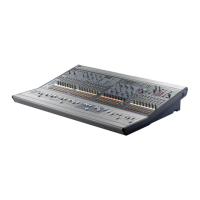
Do you have a question about the DigiDesign D-Show Profile and is the answer not in the manual?
| Type | Digital Mixing Console |
|---|---|
| Sample Rate | 48kHz |
| Bit Depth | 24-bit |
| Channels | 48 |
| Faders | 24 faders |
| Outputs | 16 |
| EQ | 4-band parametric EQ |
| Software | D-Show |
| Expandability | Yes |
Explains the input channel strips, faders, and associated controls for mixing and routing.
Describes the two main operating modes for system setup and performance mixing.
Configure DSP resources, bus settings, and system parameters.
Setting the number of input channels and FX returns available in the system.
Explains available output busses like Mains, Groups, Auxes, Matrixes, and Personal Qs.
Routing input channels and FX returns to group busses.
Shows hardware I/O and D-Show channels for creating patch points.
Step-by-step guide on how to route signals using the Patchbay grid.
Details input level, gain reduction, EQ, stereo, and gate status meters.
Explains Pre-Fader Listen (PFL), After-Fader Listen (AFL), and Solo In Place (SIP) modes.
Assigning and activating mute groups for simultaneous channel muting.
Details the parameters and operation of the built-in compressor/limiter.
Explains the parameters and operation of the built-in expander/gate.
Details HPF, parametric EQ, and EQ In/Out status for channels and busses.
Instructions for connecting outboard gear for hardware inserts.
Assigning hardware inserts to channels or busses via Inputs, Outputs, or Patchbay.
Steps for installing, assigning, routing, viewing, and saving plug-ins.
Procedures for installing and authorizing plug-ins on D-Show systems.
Overview of the four plug-in racks, slots, naming, and views.
Adjusting plug-in parameters from the control surface or software screen.
How to create, duplicate, rename, and delete Show Folders and Show Files.
Explanation of Show files, which contain console settings, snapshots, and events.
Copying data between D-Show and portable storage devices or standalone software.
Controls for storing, recalling, and managing snapshots for automated performances.
Overview of the Event List system for defining triggers and actions.
Defining conditions (triggers) that initiate events, including logical operators.
Defining console functions (actions) that occur when an event is triggered.
Using MIDI Time Code (MTC) to automate snapshot recall.
Steps for installing the D-Show Standalone software.
Table of common problems, causes, and solutions for D-Show errors and messages.
Procedures for system startup, restarts, and handling system failures.
